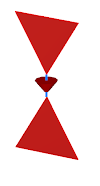Bow-Tie Antenna Design in CST MWS
Antenna Theory: A bowtie antenna uses triangular elements instead of straight rods as the antenna elements. The triangular elements sticking out on both sides of the antenna resemble a bow tie, hence the name. The “wings” of the antenna flare out symmetrically on both sides of the supporting beam. A bowtie antenna is sometimes called a butterfly antenna because it looks like a butterfly with its wings held open. When the bow tie elements have a metal bar that closes the antenna, it may be called a cat’s whisker antenna. The bowtie antenna is a type of UHF fan dipole antenna. Bow tie antennas may resemble log periodic antennas, but they are not considered LP antennas. The bandwidth of the antenna is increased by using triangular elements over straight ones. Furthermore, the antennas often receive signals from a 60-degree angle, perfect for receiving signals from various sources. This is why bowtie antennas were commonly used with televisions receiving over the air broadcasts. They could receive a wide range of UHF signals, and it will do much better than a thin wire dipole antenna in this regard.
Advantages
It is easy to design and better symmetry in radiation.
It has small size and low weight as compared to other antennas
It is low cost antenna and easy maintenance.
Disadvantages
It has poor transmitting efficiencies in the range of frequencies.
Applications: This antenna is used for low frequency applications like GPR.
Designing of Bow-Tie Antenna in CST MWS.
Objective: To design a bowtie antenna at resonating frequency of 2000 MHZ.
Step 1. Create new project template
Step-2. Use Frequency Min: 0 GHz and Frequency Max: 6 GHz
Step-3. Create 3D Curve.
Step-5 Use Extrude Curve
Step-9 Mirror the object 180 degree.
Step-10 Use picks option and pick the edge points of bow tie and apply discrete port.
Step 11. Results and Analysis.
Return loss of antenna is shown below which shows that antenna resonates very well at the center frequency with minimum return loss less than -10dB.
Step 12. Conclusion
In this tutorial the Bow Tie antenna was completely explained and designed in CST microwave studio. All of the results of antenna were sufficient and meet the requirements.

















0 Comments